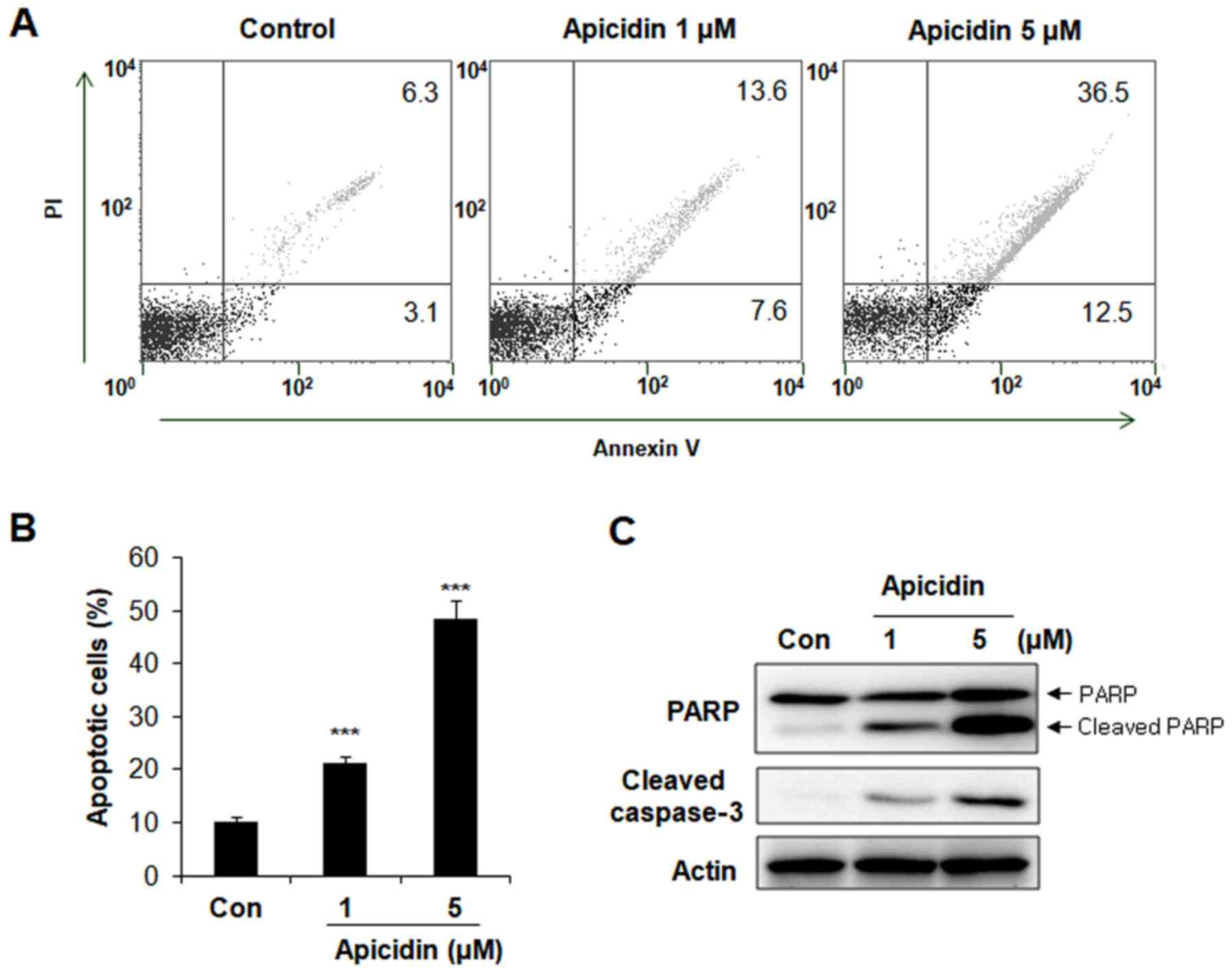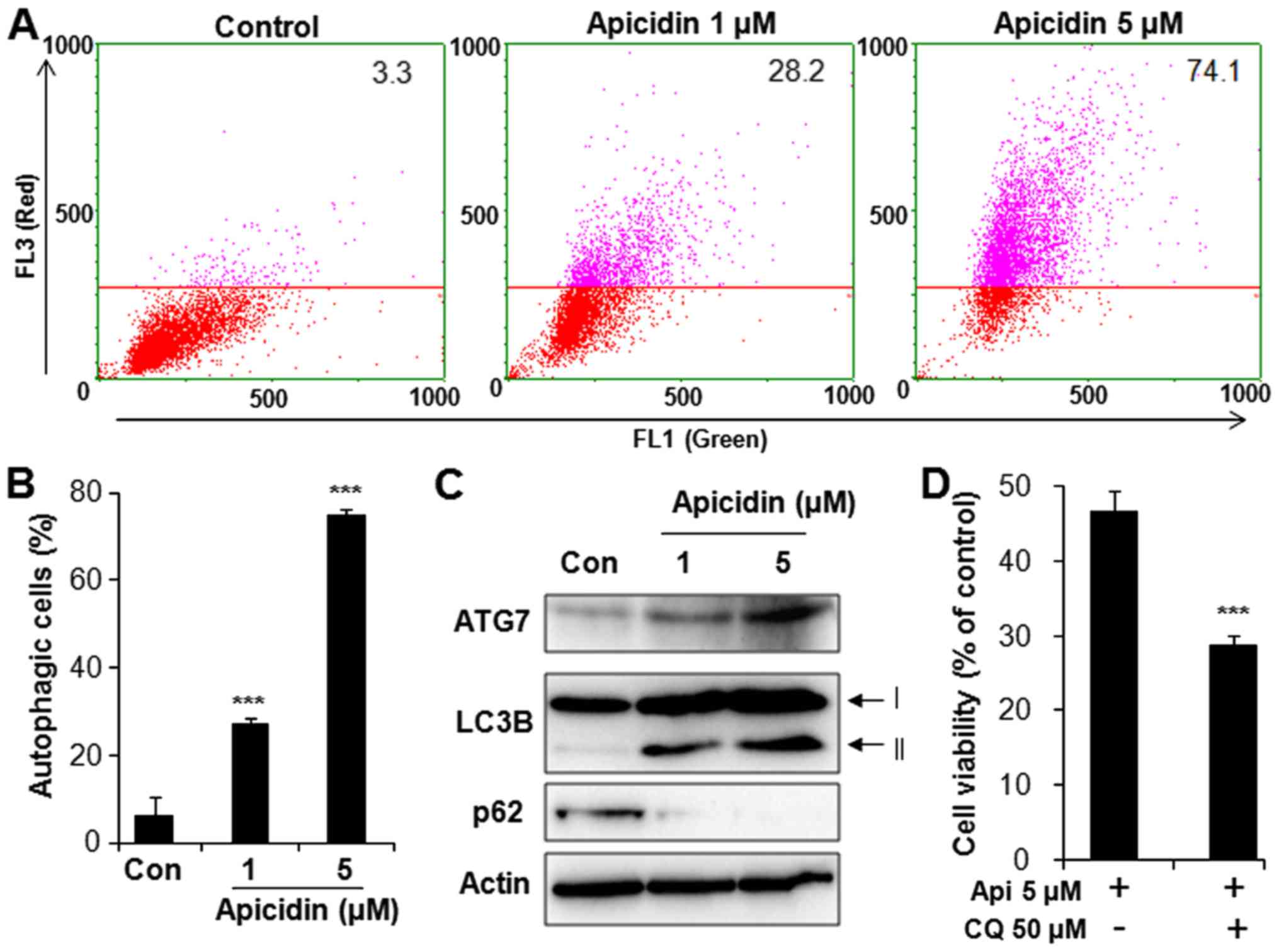|
1
|
Manal M, Chandrasekar MJ, Gomathi Priya J
and Nanjan MJ: Inhibitors of histone deacetylase as antitumor
agents: A critical review. Bioorg Chem. 67:18–42. 2016. View Article : Google Scholar : PubMed/NCBI
|
|
2
|
Dokmanovic M, Clarke C and Marks PA:
Histone deacetylase inhibitors: Overview and perspectives. Mol
Cancer Res. 5:981–989. 2007. View Article : Google Scholar : PubMed/NCBI
|
|
3
|
Iizuka M and Smith MM: Functional
consequences of histone modifications. Curr Opin Genet Dev.
13:154–160. 2003. View Article : Google Scholar : PubMed/NCBI
|
|
4
|
Marks P, Rifkind RA, Richon VM, Breslow R,
Miller T and Kelly WK: Histone deacetylases and cancer: Causes and
therapies. Nat Rev Cancer. 1:194–202. 2001. View Article : Google Scholar : PubMed/NCBI
|
|
5
|
Ahn MY and Yoon JH: Histone deacetylase 8
as a novel therapeutic target in oral squamous cell carcinoma.
Oncol Rep. 37:540–546. 2017. View Article : Google Scholar : PubMed/NCBI
|
|
6
|
Kim HJ and Bae SC: Histone deacetylase
inhibitors: Molecular mechanisms of action and clinical trials as
anti-cancer drugs. Am J Transl Res. 3:166–179. 2011.PubMed/NCBI
|
|
7
|
Batty N, Malouf GG and Issa JP: Histone
deacetylase inhibitors as anti-neoplastic agents. Cancer Lett.
280:192–200. 2009. View Article : Google Scholar : PubMed/NCBI
|
|
8
|
Grant S and Dai Y: Histone deacetylase
inhibitors and rational combination therapies. Adv Cancer Res.
116:199–237. 2012. View Article : Google Scholar : PubMed/NCBI
|
|
9
|
Bauden M, Tassidis H and Ansari D: In
vitro cytotoxicity evaluation of HDAC inhibitor Apicidin in
pancreatic carcinoma cells subsequent time and dose dependent
treatment. Toxicol Lett. 236:8–15. 2015. View Article : Google Scholar : PubMed/NCBI
|
|
10
|
Ahn MY, Kang DO, Na YJ, Yoon S, Choi WS,
Kang KW, Chung HY, Jung JH, do Min S and Kim HS: Histone
deacetylase inhibitor, apicidin, inhibits human ovarian cancer cell
migration via class II histone deacetylase 4 silencing. Cancer
Lett. 325:189–199. 2012. View Article : Google Scholar : PubMed/NCBI
|
|
11
|
Cheong JW, Chong SY, Kim JY, Eom JI, Jeung
HK, Maeng HY, Lee ST and Min YH: Induction of apoptosis by
apicidin, a histone deacetylase inhibitor, via the activation of
mitochondria-dependent caspase cascades in human Bcr-Abl-positive
leukemia cells. Clin Cancer Res. 9:5018–5027. 2003.PubMed/NCBI
|
|
12
|
Lai JP, Sandhu DS, Moser CD, Cazanave SC,
Oseini AM, Shire AM, Shridhar V, Sanderson SO and Roberts LR:
Additive effect of apicidin and doxorubicin in sulfatase 1
expressing hepatocellular carcinoma in vitro and in vivo. J
Hepatol. 50:1112–1121. 2009. View Article : Google Scholar : PubMed/NCBI
|
|
13
|
Zhang J, Lai Z, Huang W, Ling H, Lin M,
Tang S, Liu Y and Tao Y: Apicidin inhibited proliferation and
invasion and induced apoptosis via mitochondrial pathway in
non-small cell lung cancer GLC-82 cells. Anticancer Agents Med
Chem. 17:1374–1382. 2017. View Article : Google Scholar : PubMed/NCBI
|
|
14
|
Bauden M, Tassidis H and Ansari D: In
vitro cytotoxicity evaluation of HDAC inhibitor Apicidin in
pancreatic carcinoma cells subsequent time and dose dependent
treatment. Toxicol Lett. 236:8–15. 2015. View Article : Google Scholar : PubMed/NCBI
|
|
15
|
Ahn MY, Ahn JW, Kim HS, Lee J and Yoon JH:
Apicidin inhibits cell growth by downregulating IGF-1R in salivary
mucoepidermoid carcinoma cells. Oncol Rep. 33:1899–1907. 2015.
View Article : Google Scholar : PubMed/NCBI
|
|
16
|
Keleş E, Lianeri M and Jagodziński PP:
Apicidin suppresses transcription of 17β-hydroxysteroid
dehydrogenase type 1 in endometrial adenocarcinoma cells. Mol Biol
Rep. 38:3355–3360. 2011. View Article : Google Scholar : PubMed/NCBI
|
|
17
|
Markopoulos AK: Current aspects on oral
squamous cell carcinoma. Open Dent J. 6:126–130. 2012. View Article : Google Scholar : PubMed/NCBI
|
|
18
|
Cheng YS, Rees T and Wright J: A review of
research on salivary biomarkers for oral cancer detection. Clin
Transl Med. 3:32014. View Article : Google Scholar : PubMed/NCBI
|
|
19
|
Park JW, Kim CH, Ha YC, Kim MY and Park
SM: Count of platelet and mean platelet volume score: Serologic
prognostic factor in patients with oral squamous cell carcinoma. J
Korean Assoc Oral Maxillofac Surg. 43:305–311. 2017. View Article : Google Scholar : PubMed/NCBI
|
|
20
|
Ahn MY, Ahn SG and Yoon JH: Apicidin, a
histone deaceylase inhibitor, induces both apoptosis and autophagy
in human oral squamous carcinoma cells. Oral Oncol. 47:1032–1038.
2011. View Article : Google Scholar : PubMed/NCBI
|
|
21
|
Lou E, Kellman RM, Hutchison R and
Shillitoe EJ: Clinical and pathological features of the murine
AT-84 orthotopic model of oral cancer. Oral Dis. 9:305–312. 2003.
View Article : Google Scholar : PubMed/NCBI
|
|
22
|
Schultz-Hector S and Haghayegh S:
Beta-fibroblast growth factor expression in human and murine
squamous cell carcinomas and its relationship to regional
endothelial cell proliferation. Cancer Res. 53:1444–1449.
1993.PubMed/NCBI
|
|
23
|
Hier MP, Black MJ, Shenouda G, Sadeghi N
and Karp S: A murine model for the immunotherapy of head and neck
squamous cell carcinoma. Laryngoscope. 105:1077–1080. 1995.
View Article : Google Scholar : PubMed/NCBI
|
|
24
|
Pang S, Kang MK, Kung S, Yu D, Lee A, Poon
B, Chen IS, Lindemann B and Park NH: Anticancer effect of a
lentiviral vector capable of expressing HIV-1 Vpr. Clin Cancer Res.
7:3567–3573. 2001.PubMed/NCBI
|
|
25
|
Murakami J, Asaumi J, Maki Y, Tsujigiwa H,
Kuroda M, Nagai N, Yanagi Y, Inoue T, Kawasaki S, Tanaka N, et al:
Effects of demethylating agent 5-aza-2(')-deoxycytidine and histone
deacetylase inhibitor FR901228 on maspin gene expression in oral
cancer cell lines. Oral Oncol. 40:597–603. 2004. View Article : Google Scholar : PubMed/NCBI
|
|
26
|
Chung YL, Lee MY and Pui NN: Epigenetic
therapy using the histone deacetylase inhibitor for increasing
therapeutic gain in oral cancer: Prevention of radiation-induced
oral mucositis and inhibition of chemical-induced oral
carcinogenesis. Carcinogenesis. 30:1387–1397. 2009. View Article : Google Scholar : PubMed/NCBI
|
|
27
|
Rikiishi H: Autophagic and apoptotic
effects of HDAC inhibitors on cancer cells. J Biomed Biotechnol.
2011:8302602011. View Article : Google Scholar : PubMed/NCBI
|
|
28
|
Balasubramanian S, Verner E and Buggy JJ:
Isoform-specific histone deacetylase inhibitors: The next step?
Cancer Lett. 280:211–221. 2009. View Article : Google Scholar : PubMed/NCBI
|
|
29
|
Kim SN, Choi HY and Kim YK: Regulation of
adipocyte differentiation by histone deacetylase inhibitors. Arch
Pharm Res. 32:535–541. 2009. View Article : Google Scholar : PubMed/NCBI
|
|
30
|
Ahn MY and Yoon JH: Histone deacetylase 7
silencing induces apoptosis and autophagy in salivary
mucoepidermoid carcinoma cells. J Oral Pathol Med. 46:276–283.
2017. View Article : Google Scholar : PubMed/NCBI
|
|
31
|
Chang HH, Chiang CP, Hung HC, Lin CY, Deng
YT and Kuo MY: Histone deacetylase 2 expression predicts poorer
prognosis in oral cancer patients. Oral Oncol. 45:610–614. 2009.
View Article : Google Scholar : PubMed/NCBI
|
|
32
|
Sakuma T, Uzawa K, Onda T, Shiiba M, Yokoe
H, Shibahara T and Tanzawa H: Aberrant expression of histone
deacetylase 6 in oral squamous cell carcinoma. Int J Oncol.
29:117–124. 2006.PubMed/NCBI
|
|
33
|
Eisenberg-Lerner A, Bialik S, Simon HU and
Kimchi A: Life and death partners: Apoptosis, autophagy and the
cross-talk between them. Cell Death Differ. 16:966–975. 2009.
View Article : Google Scholar : PubMed/NCBI
|
|
34
|
Ahn MY, Lee J, Na YJ, Choi WS, Lee BM,
Kang KW and Kim HS: Mechanism of apicidin-induced cell cycle arrest
and apoptosis in Ishikawa human endometrial cancer cells. Chem Biol
Interact. 179:169–177. 2009. View Article : Google Scholar : PubMed/NCBI
|
|
35
|
Alirezaei M, Kemball CC, Flynn CT, Wood
MR, Whitton JL and Kiosses WB: Short-term fasting induces profound
neuronal autophagy. Autophagy. 6:702–710. 2010. View Article : Google Scholar : PubMed/NCBI
|
|
36
|
Yonekawa T and Thorburn A: Autophagy and
cell death. Essays Biochem. 55:105–117. 2013. View Article : Google Scholar : PubMed/NCBI
|
|
37
|
Ahn MY, Chung HY, Choi WS, Lee BM, Yoon S
and Kim HS: Anti-tumor effect of apicidin on Ishikawa human
endometrial cancer cells both in vitro and in vivo by blocking
histone deacetylase 3 and 4. Int J Oncol. 36:125–131.
2010.PubMed/NCBI
|
|
38
|
Nair DV and Reddy AG: Mouse models of oral
cancer: Challenges and opportunities. Int J Adv Biol Res.
7:203–207. 2017.
|
|
39
|
Muskhelishvili L, Latendresse JR, Kodell
RL and Henderson EB: Evaluation of cell proliferation in rat
tissues with BrdU, PCNA, Ki-67(MIB-5) immunohistochemistry and in
situ hybridization for histone mRNA. J Histochem Cytochem.
51:1681–1688. 2003. View Article : Google Scholar : PubMed/NCBI
|
|
40
|
Velu P, Vinothkumar V, Babukumar S and
Ramachandhiran D: Chemopreventive effect of syringic acid on
7,12-dimethylbenz(a)anthracene induced hamster buccal pouch
carcinogenesis. Toxicol Mech Methods. 27:631–640. 2017. View Article : Google Scholar : PubMed/NCBI
|
|
41
|
Saraç S, Ayhan A, Hosal AS and Kaya S:
Prognostic significance of PCNA expression in laryngeal cancer.
Arch Otolaryngol Head Neck Surg. 124:1321–1324. 1998. View Article : Google Scholar : PubMed/NCBI
|
|
42
|
Guo X, Ruan H, Li X, Qin L, Tao Y, Qi X,
Gao J, Gan L, Duan S and Shen W: Subcellular localization of class
I histone deacetylases in the developing xenopus tectum. Front Cell
Neurosci. 9:5102016. View Article : Google Scholar : PubMed/NCBI
|
|
43
|
Li Y, Shin D and Kwon SH: Histone
deacetylase 6 plays a role as a distinct regulator of diverse
cellular processes. FEBS J. 280:775–793. 2013.PubMed/NCBI
|
|
44
|
Yang WM, Tsai SC, Wen YD, Fejer G and Seto
E: Functional domains of histone deacetylase-3. J Biol Chem.
277:9447–9454. 2002. View Article : Google Scholar : PubMed/NCBI
|
|
45
|
Grozinger CM and Schreiber SL: Regulation
of histone deacetylase 4 and 5 and transcriptional activity by
14-3-3-dependent cellular localization. Proc Natl Acad Sci USA.
97:7835–7840. 2000. View Article : Google Scholar : PubMed/NCBI
|
|
46
|
Nakagawa M, Oda Y, Eguchi T, Aishima S,
Yao T, Hosoi F, Basaki Y, Ono M, Kuwano M, Tanaka M and Tsuneyoshi
M: Expression profile of class I histone deacetylases in human
cancer tissues. Oncol Rep. 18:769–774. 2007.PubMed/NCBI
|














